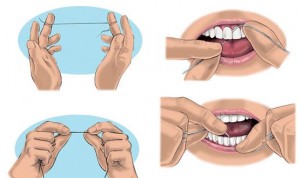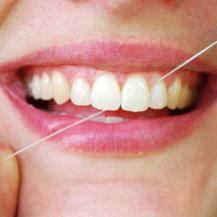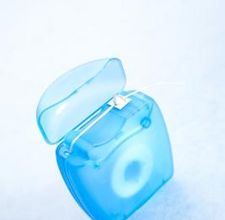Your dentist or other dental professionals usually tends to advise you to floss your teeth after every meal or before you go to bed. Some may ponder on the purpose of dental flossing or some may even not have the slightest clue what floss is to begin with.
What is flossing?
Dental floss is a string-like dental device that is indicated for plaque and debris removal in areas where teeth contact with each other. Floss is made of either a bundle of thin nylon filaments or a plastic that is best used in areas where the gums fill the space between teeth and the teeth are in contact. The floss is gently inserted between the teeth and scraped along the teeth sides, especially close to the gums. An alternative tool to achieve the same effect is the interdental brush, which is more helpful in areas where the gums have receded in between the teeth.
How does tooth flossing help in my oral hygiene regime?
Effective use of dental floss accomplishes the following objectives:
- Removes plaque and food debris that adheres to the teeth, fillings, orthodontic appliances, fixed prostheses and pontics, gums in the interproximal embrasures (the space below the area where teeth contact each other), and around dental implants.
- May arrest or prevent cavities in between teeth.
- Reduces bleeding gums.
- May be used as a vehicle for the application of polishing or chemotherapeutic agents to areas between teeth and areas beneath the gums.
Types of dental floss
Not all contact areas between teeth, whether natural or restored, have the same configuration. Consequently, several types of floss are available to accommodate these differences. These vary from thin unwaxed varieties, to thicker waxed tapes, flavored or unflavored, and include variable thickness floss. Research has shown no significant differences in the cleansing ability between waxed and unwaxed floss.
Unwaxed floss is frequently recommended because it is thin and slips easily through tight contact areas. However, unwaxed floss can fray and tear when contacting rotated teeth, heavy tartar deposits, or defective and overhanging fillings. Frequent floss breakage may discourage continued use. For these conditions, waxed, lightly waxed, or shred-resistant floss are recommended.
Waxed dental tape, unlike round dental floss, is broad and flat, and may be effective in an space between teeth without tight contact points. Additional types of floss, such as those made of polytetrafluoroethylene (PTFE, teflon-like), are stronger and more shred-resistant. They have been shown to be preferred by those who have tight contacts or rough proximal tooth surfaces.Other varieties, such as tufted floss increments alternated with standard floss, and floss which stretches for insertion are alternatives.
Some brands of dental floss and tape are colored and flavored. In addition to increased appeal, color provides a visual contrast to plaque and oral debris, thus enabling one to see what is being removed, possibly increasing the motivation to floss. Flosses infused with a variety of agents have been introduced; examples of these include floss treated with baking soda, fluoride, herbal extracts, antimicrobial agents, or abrasives for whitening.
One type of variable-thickness floss has a stiff end to allow for threading under bridges, beneath tight contact areas, under pontics (artificial teeth), through exposed areas between the teeth roots, and around orthodontic wires. This floss combines a section of unwaxed floss with an area of thicker nylon meshwork to clean larger surface areas. Variable thickness floss may be recommended for use in cleaning dental implant abutments, areas with open contacts between teeth, wide gumline opening between teeth (embrasures), or sites where receding gums and bone loss permit access to the area between the teeth roots. It can also be used to remove plaque from the back aspect of the furthermost tooth in all corners of the mouth.
When selecting a type of floss, the specific conditions of the mouth, the individual’s preference, and ability are all factors that need to be considered. A limitation of flossing is the inability to conform to a concave surface in between teeth such as the front surface of upper premolars. Other dental devices will clean those surfaces more effectively.
When to floss?
 The American Dental Association advises flossing your teeth thoroughly be done once or more per day. Overly vigorous or incorrect teeth flossing can result in damage to the gum tissues.
The American Dental Association advises flossing your teeth thoroughly be done once or more per day. Overly vigorous or incorrect teeth flossing can result in damage to the gum tissues.
How to floss?
For proper flossing of teeth, the American Dental Association advises users to curve the floss against the side of the tooth in a ‘C’ shape and then to wipe the tooth from under the gumline gently to the tip two or three times, repeated on adjacent and subsequent teeth.

